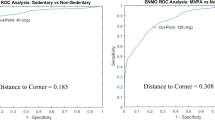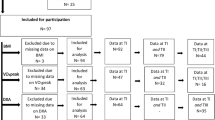Abstract
Study design
Cross-sectional validation study.
Objectives
To develop a raw acceleration signal-based random forest (RF) model for predicting total energy expenditure (TEE) in manual wheelchair users (MWUs) and evaluate the preliminary field validity of this new model, along with four existing models published in prior literature, using the Doubly Labeled Water (DLW) method.
Setting
General community and research institution in Pittsburgh, USA.
Methods
A total of 78 participants’ data from two previous studies were used to develop the new RF model. A seven-day cross-sectional study was conducted to collect participants’ free-living physical activity and TEE data, resting metabolic rate, demographics, and anthropometrics. Ten MWUs with spinal cord injury (SCI) completed the study, with seven participants having valid data for evaluating the preliminary field validity of the five models.
Results
The RF model achieved a mean absolute error (MAE) of 0.59 ± 0.60 kcal/min and a mean absolute percentage error (MAPE) of 23.6% ± 24.3% on the validation set. For preliminary field validation, the five assessed models yielded MAE from 136 kcal/day to 1141 kcal/day and MAPE from 6.1% to 50.2%. The model developed by Nightingale et al. in 2015 achieved the best performance (MAE: 136 ± 96 kcal/day, MAPE: 6.1% ± 4.7%), while the RF model achieved comparable performance (MAE: 167 ± 99 kcal/day, MAPE: 7.4% ± 5.1%).
Conclusions
Two existing models and our newly developed RF model showed good preliminary field validity for assessing TEE in MWUs with SCI and the potential to detect lifestyle change in this population. Future large-scale field validation studies and model iteration are recommended.
Similar content being viewed by others
Log in or create a free account to read this content
Gain free access to this article, as well as selected content from this journal and more on nature.com
or
Data availability
The datasets supporting this study and the developed total energy expenditure prediction model are available upon reasonable request from the corresponding author.
References
Keim NL, Blanton CA, Kretsch MJ. America’s obesity epidemic: measuring physical activity to promote an active lifestyle. J Am Dietetic Assoc. 2004;104:1398–409.
Ball EJ, O’Connor J, Abbott R, Steinbeck KS, Davies PS, Wishart C, et al. Total energy expenditure, body fatness, and physical activity in children aged 6-9 y. Am J Clin Nutr. 2001;74:524–8.
Gorgey AS, Gater DR Jr. Prevalence of obesity after spinal cord injury. Top Spinal Cord Inj Rehabil. 2007;12:1–7.
Nightingale TE, Williams S, Thompson D, Bilzon JLJ. Energy balance components in persons with paraplegia: daily variation and appropriate measurement duration. Int J Behav Nutr Phys Act. 2017;14:132.
Farkas GJ, Sneij A, Gater DR Jr. Energy expenditure following spinal cord injury: a delicate balance. Top Spinal Cord Inj Rehabil. 2021;27:92–9.
Dorstyn DS, Chur-Hansen A, Mansell E, Murphy G, Roberts RM, Stewart P, et al. Facilitators and barriers to employment for persons with chronic spinal cord injury or disorder: A qualitative study framed by the person-environment-occupation model. J Spinal Cord Med. 2023;46:246–55.
Nightingale TE, Rouse PC, Thompson D, Bilzon JLJ. Measurement of physical activity and energy expenditure in wheelchair users: methods, considerations and future directions. Sports Med Open. 2017;3:10.
Tsang K. Using Wearable Sensors for Physical Activity Measurement and Promotion in Manual Wheelchair Users [Internet] [Ph.D.]. [United States -- Pennsylvania]: University of Pittsburgh; [cited 2024 Jul 2]. Available from: https://www.proquest.com/docview/2164892371/abstract?parentSessionId=f55PhHJEQNhkU2mFwY8iqHQIVzyzx4TcQYLe7WapQYg%3D&sourcetype=Dissertations%20&%20Theses.
Tanhoffer RA, Tanhoffer AI, Raymond J, Hills AP, Davis GM. Comparison of methods to assess energy expenditure and physical activity in people with spinal cord injury. J Spinal Cord Med. 2012;35:35–45.
Schoeller DA. Measurement of energy expenditure in free-living humans by using doubly labeled water. J Nutr. 1988;118:1278–89.
Seale JL, Conway JM, Canary JJ. Seven-day validation of doubly labeled water method using indirect room calorimetry. J Appl Physiol. 1993;74:402–9.
Desneves KJ, Panisset MG, Rafferty J, Rodi H, Ward LC, Nunn A, et al. Comparison of estimated energy requirements using predictive equations with total energy expenditure measured by the doubly labelled water method in acute spinal cord injury. Spinal Cord. 2019;57:562–70.
Tudor-Locke CE, Myers AM. Challenges and opportunities for measuring physical activity in sedentary adults. Sports Med. 2001;31:91–100.
Ridgers ND, McNarry MA, Mackintosh KA. Feasibility and effectiveness of using wearable activity trackers in youth: a systematic review. JMIR mHealth uHealth. 2016;4:e6540.
Tanhoffer RA, Tanhoffer AI, Raymond J, Johnson NA, Hills AP, Davis GM. Energy expenditure in individuals with spinal cord injury quantified by doubly labeled water and a multi-sensor armband. J Phys Act Health. 2015;12:163–70.
Shwetar YJ, Veerubhotla AL, Huang Z, Ding D. Comparative validity of energy expenditure prediction algorithms using wearable devices for people with spinal cord injury. Spinal Cord. 2020;58:821–30.
O’Driscoll R, Turicchi J, Hopkins M, Horgan GW, Finlayson G, Stubbs JR. Improving energy expenditure estimates from wearable devices: a machine learning approach. J Sports Sci. 2020;38:1496–505.
Xu L, Zhang J, Li Z, Liu Y, Jia Z, Han X, et al. Comparison of different prediction models for estimation of walking and running energy expenditure based on a wristwear three-axis accelerometer. Front Physiol. 2023;14:1202737.
Nightingale TE, Walhim J-P, Thompson D, Bilzon JL. Predicting physical activity energy expenditure in manual wheelchair users. Med Sci Sports Exerc. 2014;46:1849–58.
Nightingale TE, Walhin JP, Thompson D, Bilzon JL. Influence of accelerometer type and placement on physical activity energy expenditure prediction in manual wheelchair users. PLoS ONE. 2015;10:e0126086.
Learmonth YC, Kinnett-Hopkins D, Rice IM, Dysterheft J, Motl R. Accelerometer output and its association with energy expenditure during manual wheelchair propulsion. Spinal Cord. 2016;54:110–4.
García-Massó X, Serra-Añó P, García-Raffi LM, Sánchez-Pérez EA, López-Pascual J, González L-M. Validation of the use of Actigraph GT3X accelerometers to estimate energy expenditure in full time manual wheelchair users with spinal cord injury. Spinal Cord. 2013;51:898–903.
Shwetar Y, Huang Z, Veerubhotla A, Knezevic S, Hong E, Spungen AM, et al. Predicting physical activity intensity using raw accelerometer signals in manual wheelchair users with spinal cord injury. Spinal Cord. 2022;60:149–56.
Compher C, Frankenfield D, Keim N, Roth-Yousey L, Group EAW. Best practice methods to apply to measurement of resting metabolic rate in adults: a systematic review. J Am Dietetic Assoc. 2006;106:881–903.
Breiman L. Random forests. Mach Learn. 2001;45:5–32.
Giurgiu M, Timm I, Becker M, Schmidt S, Wunsch K, Nissen R, et al. Quality evaluation of free-living validation studies for the assessment of 24-hour physical behavior in adults via wearables: systematic review. JMIR Mhealth Uhealth. 2022;10:e36377.
Nightingale T, Walhin J, Thompson D, Bilzon J. Predicting physical activity energy expenditure in wheelchair users with a multisensor device. BMJ Open Sport Exerc Med. 2015;1:bmjsem-2015-000008.
Nightingale TE, Gorgey AS. Predicting basal metabolic rate in men with motor complete spinal cord injury. Med Sci Sports Exerc. 2018;50:1305–12.
Neishabouri A, Nguyen J, Samuelsson J, Guthrie T, Biggs M, Wyatt J, et al. Quantification of acceleration as activity counts in ActiGraph wearable. Sci Rep. 2022;12:11958.
Buchholz AC, McGillivray CF, Pencharz PB. Differences in resting metabolic rate between paraplegic and able-bodied subjects are explained by differences in body composition. Am J Clin Nutr. 2003;77:371–8.
Chun SM, Kim HR, Shin HI. Estimating the Basal metabolic rate from fat free mass in individuals with motor complete spinal cord injury. Spinal Cord. 2017;55:844–7.
Ma Y, de Groot S, Hoevenaars D, Achterberg W, Adriaansen J, Weijs PJM, et al. Predicting resting energy expenditure in people with chronic spinal cord injury. Spinal Cord. 2022;60:1100–7.
Farkas GJ, Gorgey AS, Dolbow DR, Berg AS, Gater DR. Caloric intake relative to total daily energy expenditure using a spinal cord injury-specific correction factor: an analysis by level of injury. Am J Phys Med Rehabil. 2019;98:947–52.
Monroe MB, Tataranni PA, Pratley R, Manore MM, Skinner JS, Ravussin E. Lower daily energy expenditure as measured by a respiratory chamber in subjects with spinal cord injury compared with control subjects. Am J Clin Nutr. 1998;68:1223–7.
Alfonzo-González G, Doucet E, Alméras N, Bouchard C, Tremblay A. Estimation of daily energy needs with the FAO/WHO/UNU 1985 procedures in adults: comparison to whole-body indirect calorimetry measurements. Eur J Clin Nutr. 2004;58:1125–31.
Mifflin MD, St Jeor ST, Hill LA, Scott BJ, Daugherty SA, Koh YO. A new predictive equation for resting energy expenditure in healthy individuals. Am J Clin Nutr. 1990;51:241–7.
Acknowledgements
We would like to acknowledge and thank Steven J Anthony for his assistance in conducting the field validation study protocol and data collection.
Funding
This study was funded by the Veterans Affairs (VA) Rehabilitation Research & Development under Grant # 1I01RX000971-01A2 conducted at the Human Engineering Research Laboratories (Pittsburgh, PA) and the James J. Peters VA Medical Center (Bronx, NY). This study used data from another study conducted by our team and funded by the National Institute of Disability, Independent Living and Rehabilitation Research, Rehabilitation Engineering Research Center on Recreational Technologies Benefiting Individuals with Disabilities (#H133E120005), conducted at the Human Engineering Research Laboratories (Pittsburgh, PA) and the Lakeshore Foundation (Birmingham, AL). The content is solely the responsibility of the authors and does not represent the official views of the Department of Veterans Affairs or the United States Government.
Author information
Authors and Affiliations
Contributions
ZH was responsible for conducting the study protocol, screening potential participants, performing data collection and analysis, obtaining and interpreting results, updating reference lists, and developing this paper in its entirety. ALV was responsible for designing the protocol, screening potential participants, performing data collection and analysis, obtaining and interpreting results, and editing the paper. JPD was responsible for performing data analysis, obtaining the results, and editing the paper. DD provided guidance throughout the study, including formulating the paper plan, supervising data collection, data analysis, and result interpretation, as well as editing the paper.
Corresponding author
Ethics declarations
Competing interests
The authors declare no competing interests.
Ethical approval
This study involves human participants and is in accordance with the Declaration of Helsinki. This study was approved by the Institutional Review Boards of the VA Pittsburgh Healthcare System (IRB#: 1617254) and the University of Pittsburgh (IRB#: STUDY19060030). We certify that all applicable institutional and governmental regulations concerning the ethical use of human volunteers were followed during the course of this research. Informed consent was obtained from all participants.
Additional information
Publisher’s note Springer Nature remains neutral with regard to jurisdictional claims in published maps and institutional affiliations.
Supplementary information
Rights and permissions
Springer Nature or its licensor (e.g. a society or other partner) holds exclusive rights to this article under a publishing agreement with the author(s) or other rightsholder(s); author self-archiving of the accepted manuscript version of this article is solely governed by the terms of such publishing agreement and applicable law.
About this article
Cite this article
Huang, Z., Veerubhotla, A.L., DeLany, J.P. et al. Preliminary field validity of ActiGraph-based energy expenditure estimation in wheelchair users with spinal cord injury. Spinal Cord 62, 514–522 (2024). https://doi.org/10.1038/s41393-024-01012-6
Received:
Revised:
Accepted:
Published:
Issue date:
DOI: https://doi.org/10.1038/s41393-024-01012-6



